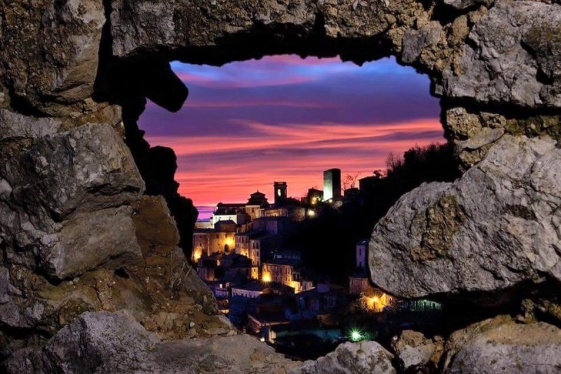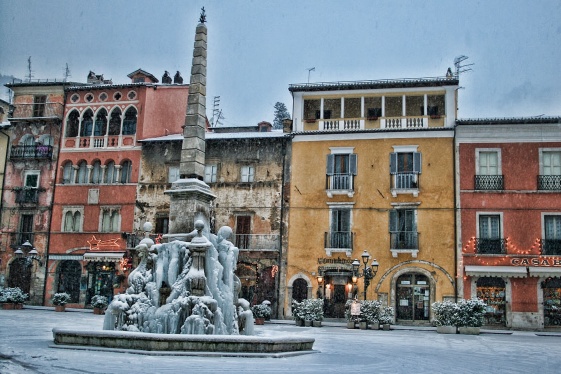
I borghi più belli d'Italia
The goal of our Club, which was not created merely as an integrated tourist promotional operation, is to guarantee - through protection, restoration, promotion and utilization - the preservation of a great heritage of monuments and memories that would otherwise be irretrievably lost. http://www.borghitalia.it/
Italian little Italies: Venosa, the City of Horace
In the Archaeological Park one can visit the Roman baths, remains of private Roman houses (domus) and the amphitheatre. Archaeological excavations have also brought to light a patrician house of the 1st century AD, called “the House of Horace,” Jewish catacombs containing a series of hypogei discovered in 1853 (the presence of a large Jewish commu...
Italian Little Italies: San Lorenzo in Banale, Efforts hidden within the walls
The village set on a large sunny green terrace overlooks the valley with the Dolomites of Brenta behind it. San Lorenzo is an ancient village created by the merging of seven Villas: Berghi, Pergnano, Senaso, Dolaso, Prato, Prusa and Glolo. Placed at the entrance of the beautiful Ambiez Valley, you can access the Adamello-Brenta Nature Park from the...
Italian Little Italies: San Donato Val di Comino, land of passage
San Donato is a village of ancient houses leaned on the slopes of the Apennines, on the cliffs of Monte Pizzuto, covered by beech forests. The Val di Comino opens southwards as a bowl, with its tiny country streets and prismatic fields of green and yellow; northwards, beyond mountains, there is the wilderness of the National Park of Abruzzo, in its...
Italian Little Italies: Castelsardo, A Fortress on the Sea
Perched on a large promontory facing the sea, Castelsardo with its Citadel, o Casteddu quarter - the maze of twisted narrow streets in the old town - offers an enchanting vision. In fact just about anywhere you look, from whatever perspective - with the exception of the view of the modern quarter of Pianedda and the seaside area by the Marine - the...
Italian Little Italies: Tagliacozzo, The ancient capital of Marsica
On the northern slopes of the Simbruini mountains, not away from the border of Lazio, Tagliacozzo is an historical centre whose walls erected in 1410 counted five doors and whose defence was submitted to a castle, in total ruin today. The best interesting part is the one meeting over the Roman arc toward the inside.
Italian Little Italies: Apricale, the Kiss of Stone and Sun
Apricale is unique. Picturesquely arranged around the small square, it has a stepped appearance, with the old stone buildings rising on several levels: thus it happens that the entrance is at the top floor, and you need to go down the stairs to get to the rest of the house.
Italian little italies: Castiglione di Sicilia, Among the Alcantara and the Mount Etna
Castiglione stands on a rise overlooking the southern shore of the Alcantara river, with houses set on a steep slope; the locations of the civil and religious power are both on the highest point of the hill.
Italian little italies: Chianalea di Scilla, Calabria
The oldest district of Scilla is Chianalea, which takes its name from “piano della galea” (galley deck), but it is also called Acquagrande or Canalea, because the little houses built directly on the rocks are separated one from the other by small alleys, like channels, which descend directly into the Tyrrhenian Sea.
Italian little italies: Giglio Castello, Toscana
The name does not derive from the beautiful fragrant flower (lily) but from the Greek word igilio (goat) that in Latin is Gilium. In fact, on this island, as well as on the others of the Tuscany archipelago, many wild goats still exist on Montecristo Island. Giglio Castello, that still preserves the walls that originated its name, was once called “...
Italian little italies: San Leo, Emilia Romagna
San Leone, together with San Marino, came here from the coast of Dalmazia to evangelize this area, the name of the village is a tribute to San Leone. The fortress of San Leo (nearly 600 feet high) overlooks the surrounding valley with the Marecchia river and a landscape of woods, between the rocks and the sea. The village is surrounded by a relaxin...
Italian Little Italies: Offagna, Marche
The toponym should come from, for lexical corruption, the Massa Afraniana, a roman latifundium which belonged to the gens Afrania, an important family that had possessions in the territory.
Italian Little Italies: Cordovado, In the quiet countryside of the Friuli region
The actual fortified area of Cordovado, also known as ''The Castle'' (11th century) is the result of centuries of modifications. The modifications involved castle's walls, towers, moats and drawbridges. The medieval village is in the area of The Castle. There are some interesting buildings : beautiful dwellings (Palazzo Ridolfi, Palazzo Bozza Marru...














